
Bud’s Nature Journal: Exploring the geology of the Jornada del Muerto
As desolate as it seems, the Jornada del Muerto is anything but. In fact, it’s surface can be read as if it were a treatise rich in history.
Recently, a group of us went into the Jornada on a rockhound adventure. Many of Doña Ana’s county roads are dirt, and I rode the bumpy roads in the back seat. I recognized Point of Rocks as we headed north. Soon the car came to a stop. We were there, although I have no idea where there is except to say we were deep in the Jornada. There are no forests in the Jornada, unless you want to call some clusters of ocotillo forests. There are no rivers; only dry arroyos. There are no landmarks. It was apparent only the leader of our group knew where she was going. It was also apparent it would be easy to get lost in this desert. I guess that’s one reason it was named journey of death.
So off we went, down a sandy arroyo into a wider one. We were told the solitary cottonwood a hundred yards to our left marked the point where we’d leave the arroyos on our return. That seemed futilely inadequate. We tracked northwest for perhaps a mile, perhaps a mile and a half. We were looking for petrified wood.
Now, if you know anything about the natural history of this area, it was once either the bed of a shallow sea or seashore. There were animals predating dinosaurs ... like dimentrodon, along with a lot of other and often much smaller reptilians. And there were trees ... forests of them.
Today the desert here is sparse. Scattered creosote bush, an odd prickly pear or ocotillo cactus, an even rarer mesquite, and virtually no grass. There’s lots of bare earth, so the search for fossils didn’t take long before one of us shouted, “I found some.” It wasn’t me, and I hurried to see what petrified wood here in the Jornada looked like. I had seen fossils in the Petrified Forest National Monument in Arizona, but I needed a search image to find them in the Jornada.
I examined the lemon-size chunk of rock. Yes, I could see the veins of wood running vertically; the rings arcing horizontally. It was petrified wood alright. It was interesting, but my attention turned to an even more fascinating geological phenomenon just laying there on the ground ... small, dark, round rocks. They were iron and covered the ground like marbles. Some were as small as peas; others the size of golf balls. Some stuck together, like Nipples of Venus or Twinkies. Some had clustered and had the appearance of bubbly crust on a Brown Betty cobbler. It was obvious they had eroded from the sandstone in which many more were still embedded. I began to wonder how they got there and reviewed my meager knowledge of geology.
This is what I concluded.
Having seen Kilauea in Hawai’i, I surmised these balls were spatter from an eruption or lava fountain. Think of it. When 3000-degree molten rock shoots into 80-degree air, it virtually freezes, usually in the form of a ball. The spatter landed in sand. Perhaps it was a beach, much like the more muddy beach where the Paleozoic fossil tracks were made. Perhaps not. Whatever its source, the sand was the landing zone for the balls. More sand covered them and, over eons, the overburden compressed the sand into sandstone. You can see the different strata of sand, especially where a thin, darker layer of some other mineral fell to ground before more sand washed over it.
Then the mountains were born and the sandstone heaved to the surface. Wind, rain, and freezing temperatures have eroded the soft sandstone, leaving the hard iron laying on the surface. I gathered some. I even collected a piece of sandstone with an embedded ball. My schoolteacher sister-in-law will appreciate them.
We had been climbing a long, low ridge and now began to skirt the highest part. On the opposite side of the ridge, I had a chin-dropping experience. There laying on the ground were several, whole petrified logs. I couldn’t determine how long they were since they were partially buried. At least five to six feet were exposed, and they’d been exposed a long time. The rock was cracked and crumbling. You couldn’t collect an entire log, even if you had the machinery to dig and lift it. But here it was, telling a story that predates dinosaurs, a story of the time when there were no mountains, not even a North America. And who knows where these trees were born? Were they temperate like our pine forests are today? Or from some tropical region near the equator? I still find it hard to believe huge pieces of earth’s crust slide over the molten core, changing places and shapes. But here was evidence as plain as the nose on my face, although my nose has chosen to remain where it’s been since birth.
The Jornada is a desert, silent and pensive. It keeps its own counsel but it’s not stingy. It will share its life story with anyone willing to walk through it, willing to observe and listen. And look beyond the human impact on the land, to a time long before there were even humans or even mammals.
The piece of ancient tree I brought home sits on my desk and I marvel at how it was formed and how it became rock. It may be my imagination, but if it had eyes, they’d twinkle; if it had a mouth, there’d be a curious, mischievous smile. It knows so much more than I do, and I long to know what it knows. Maybe I need to journey again into the Jornada, to journey again back in time and read the open pages of its history.






No comments:
Post a Comment